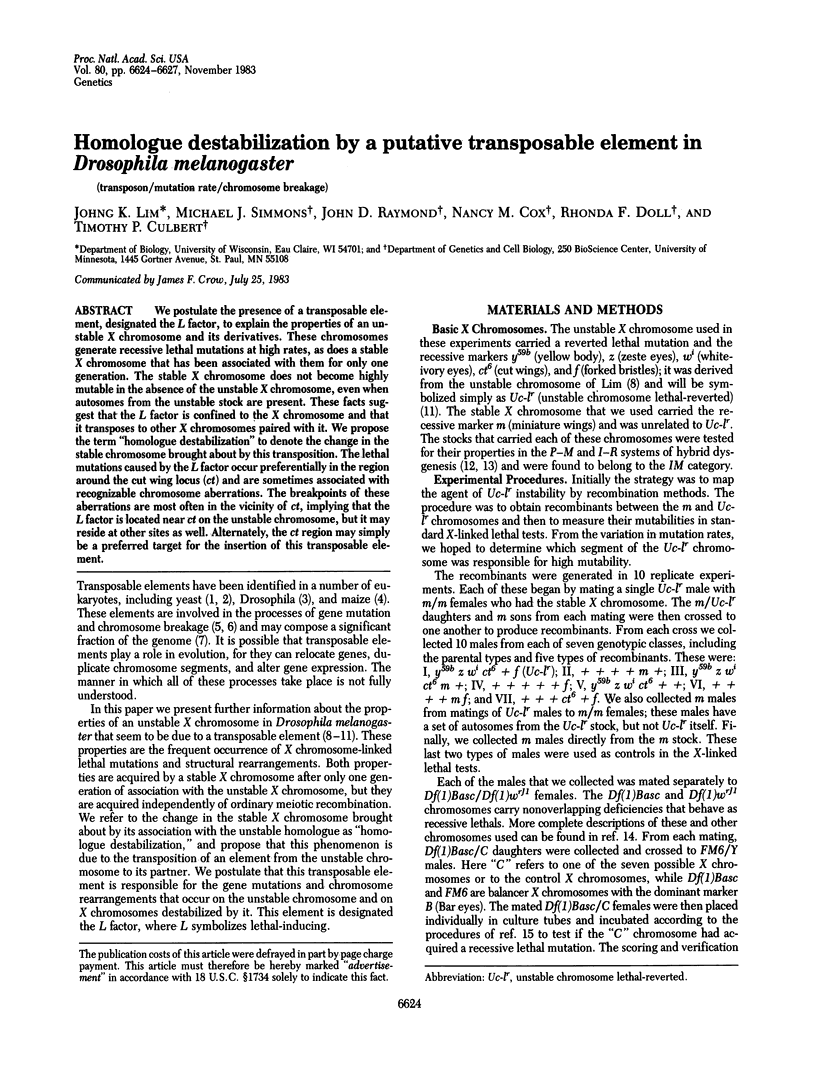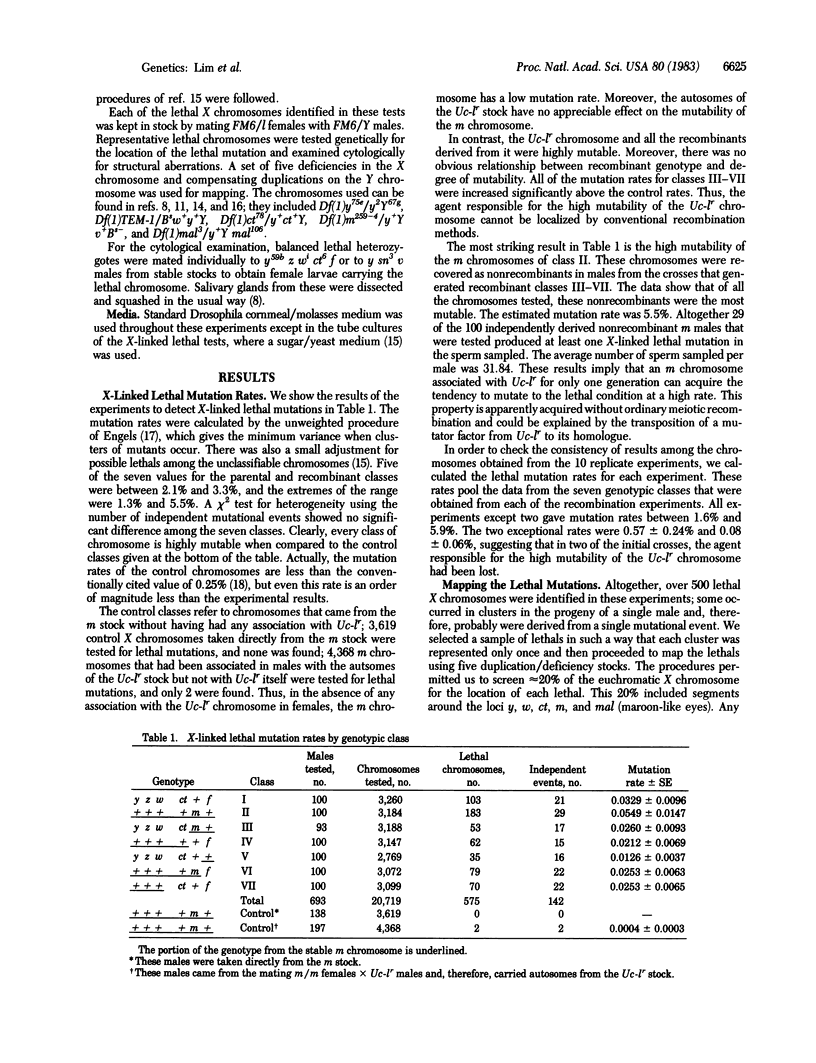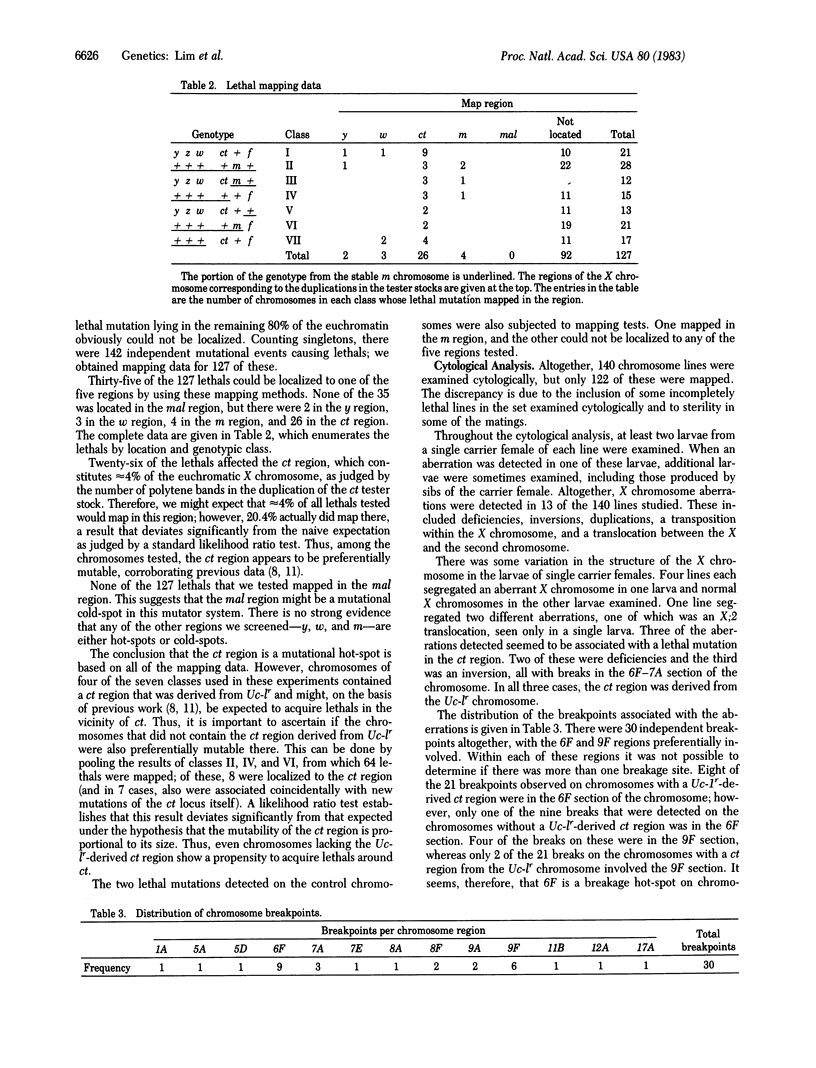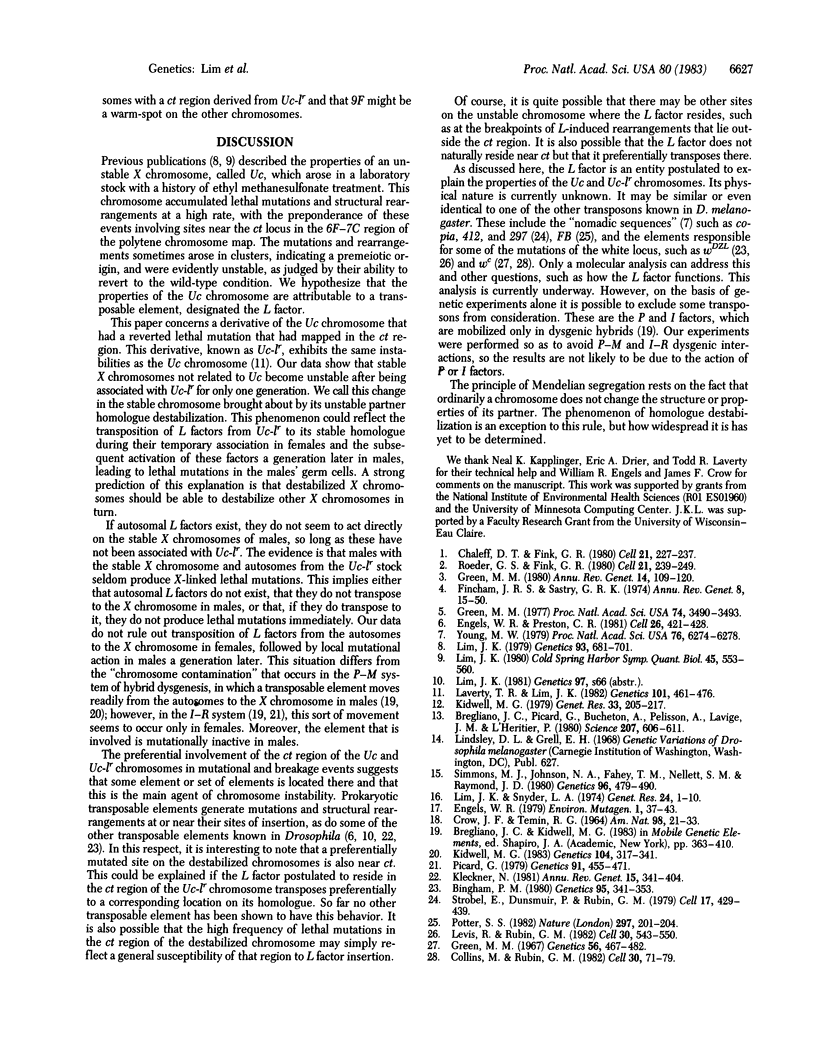Abstract
We postulate the presence of a transposable element, designated the L factor, to explain the properties of an unstable X chromosome and its derivatives. These chromosomes generate recessive lethal mutations at high rates, as does a stable X chromosome that has been associated with them for only one generation. The stable X chromosome does not become highly mutable in the absence of the unstable X chromosome, even when autosomes from the unstable stock are present. These facts suggest that the L factor is confined to the X chromosome and that it transposes to other X chromosomes paired with it. We propose the term "homologue destabilization" to denote the change in the stable chromosome brought about by this transposition. The lethal mutations caused by the L factor occur preferentially in the region around the cut wing locus (ct) and are sometimes associated with recognizable chromosome aberrations. The breakpoints of these aberrations are most often in the vicinity of ct, implying that the L factor is located near ct on the unstable chromosome, but it may reside at other sites as well. Alternately, the ct region may simply be a preferred target for the insertion of this transposable element.
Full text
PDF



Selected References
These references are in PubMed. This may not be the complete list of references from this article.
- Bingham P. M. The Regulation of White Locus Expression: A Dominant Mutant Allele at the White Locus of DROSOPHILA MELANOGASTER. Genetics. 1980 Jun;95(2):341–353. doi: 10.1093/genetics/95.2.341. [DOI] [PMC free article] [PubMed] [Google Scholar]
- Bregliano J. C., Picard G., Bucheton A., Pelisson A., Lavige J. M., L'Heritier P. Hybrid dysgenesis in Drosophila melanogaster. Science. 1980 Feb 8;207(4431):606–611. doi: 10.1126/science.6766221. [DOI] [PubMed] [Google Scholar]
- Chaleff D. T., Fink G. R. Genetic events associated with an insertion mutation in yeast. Cell. 1980 Aug;21(1):227–237. doi: 10.1016/0092-8674(80)90130-0. [DOI] [PubMed] [Google Scholar]
- Collins M., Rubin G. M. Structure of the Drosophila mutable allele, white-crimson, and its white-ivory and wild-type derivatives. Cell. 1982 Aug;30(1):71–79. doi: 10.1016/0092-8674(82)90013-7. [DOI] [PubMed] [Google Scholar]
- Engels W. R., Preston C. R. Identifying P factors in Drosophila by means of chromosome breakage hotspots. Cell. 1981 Nov;26(3 Pt 1):421–428. doi: 10.1016/0092-8674(81)90211-7. [DOI] [PubMed] [Google Scholar]
- Engels W. R. The estimation of mutation rates when premeiotic events are involved. Environ Mutagen. 1979;1(1):37–43. doi: 10.1002/em.2860010110. [DOI] [PubMed] [Google Scholar]
- Fincham J. R., Sastry G. R. Controlling elements in maize. Annu Rev Genet. 1974;8:15–50. doi: 10.1146/annurev.ge.08.120174.000311. [DOI] [PubMed] [Google Scholar]
- Green M. M. Genetic instability in Drosophila melanogaster: De novo induction of putative insertion mutations. Proc Natl Acad Sci U S A. 1977 Aug;74(8):3490–3493. doi: 10.1073/pnas.74.8.3490. [DOI] [PMC free article] [PubMed] [Google Scholar]
- Green M. M. The genetics of a mutable gene at the white locus of Drosophila melanogaster. Genetics. 1967 Jul;56(3):467–482. doi: 10.1093/genetics/56.3.467. [DOI] [PMC free article] [PubMed] [Google Scholar]
- Green M. M. Transposable elements in Drosophila and other Diptera. Annu Rev Genet. 1980;14:109–120. doi: 10.1146/annurev.ge.14.120180.000545. [DOI] [PubMed] [Google Scholar]
- Kidwell M. G. Hybrid Dysgenesis in DROSOPHILA MELANOGASTER: Factors Affecting Chromosomal Contamination in the P-M System. Genetics. 1983 Jun;104(2):317–341. doi: 10.1093/genetics/104.2.317. [DOI] [PMC free article] [PubMed] [Google Scholar]
- Kleckner N. Transposable elements in prokaryotes. Annu Rev Genet. 1981;15:341–404. doi: 10.1146/annurev.ge.15.120181.002013. [DOI] [PubMed] [Google Scholar]
- Laverty T. R., Lim J. K. Site-specific instability in Drosophila melanogaster: evidence for transposition of destabilizing element. Genetics. 1982 Jul-Aug;101(3-4):461–476. doi: 10.1093/genetics/101.3-4.461. [DOI] [PMC free article] [PubMed] [Google Scholar]
- Levis R., Rubin G. M. The unstable wDZL mutation of Drosophila is caused by a 13 kilobase insertion that is imprecisely excised in phenotypic revertants. Cell. 1982 Sep;30(2):543–550. doi: 10.1016/0092-8674(82)90251-3. [DOI] [PubMed] [Google Scholar]
- Lim J. K. Site-specific instability in Drosophila melanogaster: the origin of the mutation and cytogenetic evidence for site specificity. Genetics. 1979 Nov;93(3):681–701. doi: 10.1093/genetics/93.3.681. [DOI] [PMC free article] [PubMed] [Google Scholar]
- Lim J. K. Site-specific intrachromosomal rearrangements in Drosophila melanogaster: cytogenetic evidence for transposable elements. Cold Spring Harb Symp Quant Biol. 1981;45(Pt 2):553–560. doi: 10.1101/sqb.1981.045.01.071. [DOI] [PubMed] [Google Scholar]
- Lim J. K., Snyder L. A. Cytogenetic and complementation analyses of recessive lethal mutations induced in the X chromosome of Drosophila by three alkylating agents. Genet Res. 1974 Aug;24(1):1–10. doi: 10.1017/s0016672300015020. [DOI] [PubMed] [Google Scholar]
- Picard G. Non-Mendelian Female Sterility in DROSOPHILA MELANOGASTER: Principal Characteristics of Chromosomes from Inducer and Reactive Origin after Chromosomal Contamination. Genetics. 1979 Mar;91(3):455–471. doi: 10.1093/genetics/91.3.455. [DOI] [PMC free article] [PubMed] [Google Scholar]
- Potter S. S. DNA sequence of a foldback transposable element in Drosophila. Nature. 1982 May 20;297(5863):201–204. doi: 10.1038/297201a0. [DOI] [PubMed] [Google Scholar]
- Roeder G. S., Fink G. R. DNA rearrangements associated with a transposable element in yeast. Cell. 1980 Aug;21(1):239–249. doi: 10.1016/0092-8674(80)90131-2. [DOI] [PubMed] [Google Scholar]
- Simmons M. J., Johnson N. A., Fahey T. M., Nellett S. M., Raymond J. D. High mutability in male hybrids of Drosophila melanogaster. Genetics. 1980 Oct;96(2):479–480. doi: 10.1093/genetics/96.2.479. [DOI] [PMC free article] [PubMed] [Google Scholar]
- Strobel E., Dunsmuir P., Rubin G. M. Polymorphisms in the chromosomal locations of elements of the 412, copia and 297 dispersed repeated gene families in Drosophila. Cell. 1979 Jun;17(2):429–439. doi: 10.1016/0092-8674(79)90169-7. [DOI] [PubMed] [Google Scholar]
- Young M. W. Middle repetitive DNA: a fluid component of the Drosophila genome. Proc Natl Acad Sci U S A. 1979 Dec;76(12):6274–6278. doi: 10.1073/pnas.76.12.6274. [DOI] [PMC free article] [PubMed] [Google Scholar]


